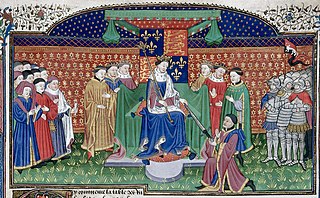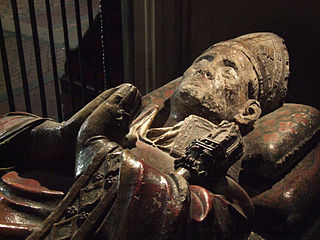Related Research Articles
Ælfsige was Bishop of Winchester before he became Archbishop of Canterbury in 959.

John Stafford was a medieval English prelate and statesman who served as Lord Chancellor (1432–1450) and as Archbishop of Canterbury (1443–1452).

Deusdedit was a medieval Archbishop of Canterbury, the first native-born holder of the see of Canterbury. By birth an Anglo-Saxon, he became archbishop in 655 and held the office for more than nine years until his death, probably from plague. Deusdedit's successor as archbishop was one of his priests at Canterbury. There is some controversy over the exact date of Deusdedit's death, owing to discrepancies in the medieval written work that records his life. Little is known about his episcopate, but he was considered to be a saint after his demise. A saint's life was written after his relics were moved from their original burial place in 1091.
John Langton was a chancellor of England and Bishop of Chichester.

Eadfrith of Lindisfarne, also known as Saint Eadfrith, was Bishop of Lindisfarne, probably from 698 onwards. By the twelfth century it was believed that Eadfrith succeeded Eadberht and nothing in the surviving records contradicts this belief. Lindisfarne was among the main religious sites of the kingdom of Northumbria in the early eighth century, the resting place of Saints Aidan and Cuthbert. He is venerated as a Saint in the Roman Catholic Church, and in the Eastern Orthodox Church, as also in the Anglican Communion.
Wighard was a medieval Archbishop-elect of Canterbury. What little is known about him comes from 8th-century writer Bede, but inconsistencies between various works have led to confusion about the exact circumstances of Wighard's election and whether he was ever confirmed in that office. What is clear is that he died in Rome after travelling there for confirmation by the papacy of his elevation to the archbishopric. His death allowed Pope Vitalian to select the next archbishop from amongst the clergy in Rome.
Sigeferth or Sigefirth or Sicgga, was the third Bishop of Selsey, consecrated in 733 by Tatwine, the Archbishop of Canterbury. Sigeferth was still bishop in 747, when he attended the Synod of Clofesho. His date of death was sometime between 747 and 765.
Æthelwine was the second bishop of Lindsey from around 680, and is regarded as a saint.
Bosa was an Anglo-Saxon Bishop of York during the 7th and early 8th centuries. He was educated at Whitby Abbey, where he became a monk. Following Wilfrid's removal from York in 678 the diocese was divided into three, leaving a greatly reduced see of York, to which Bosa was appointed bishop. He was himself removed in 687 and replaced by Wilfrid, but in 691 Wilfrid was once more ejected and Bosa returned to the see. He died in about 705, and subsequently appears as a saint in an 8th-century liturgical calendar.
Wilfrid II, name also spelled Wilfrith, also known as Wilfrid the Younger, was the last Bishop of York, as the see was converted to an archbishopric during the time of his successor.

John Sheppey was an English administrator and bishop. He served as treasurer from 1356 to 1360. Little is known of his family and background. A Benedictine, he was ordained deacon in 1318, and later studied at Oxford. Later he became involved in royal government, and was made bishop of Rochester on 22 October 1352. He was consecrated on 10 March 1353. He died on 19 October 1360, and was buried in Rochester Cathedral at the altar of St John the Baptist. As his will shows, he was a friend of his predecessor in the treasury, William Edington.
Ithamar was the first bishop in England to be Saxon-born rather than consecrated by the Irish or from among Augustine's Roman missionaries. He was also the first Saxon bishop of Rochester.
Geoffrey de Muschamp was a medieval Bishop of Coventry.

John Hotham was a medieval Chancellor of the Exchequer, Lord High Treasurer, Lord Chancellor and Bishop of Ely. He was also effective Governor of Ireland for a time.
Robert of Chichester was a medieval Bishop of Exeter.
Thomas Bitton was a medieval Bishop of Exeter.
Ralph Baldock was a medieval Bishop of London.

Richard FitzJames was a medieval Bishop of Rochester, Bishop of Chichester and Bishop of London.
John Sandale was a Gascon medieval Lord High Treasurer, Lord Chancellor and Bishop of Winchester.
References
- Fryde, E. B.; Greenway, D. E.; Porter, S.; Roy, I. (1996). Handbook of British Chronology (Third revised ed.). Cambridge: Cambridge University Press. ISBN 0-521-56350-X.
- Thacker, Alan (2004). "Deusdedit (d. 664)". Oxford Dictionary of National Biography. Oxford University Press. doi:10.1093/ref:odnb/7560 . Retrieved 21 August 2010.(subscription or UK public library membership required)